
SENIOR PROJECTS, SPRING 2023
APRIL 21 - MAY 5, 2023
Opening Reception and Artists' Presentation
Thursday, April 20 • 5-7pm
At the end of their studies, art majors are required to develop and present a coherent body of self-generated work. This exhibition combines their knowledge of techniques and concepts while drawing on research of historical and contemporary artists. Each senior art major in the exhibition designs and creates a unique installation that combines their technical skills and conceptual vision.
Sponsored by The Layden Family Foundation and The Smith Family Foundation of Estero
Image: Senior Project installation of Marcela Pulgarin, The Time I Inhabit, 2022. Photo by John Loscuito
-
Sarah Akulova Baker UNRAVELING
Toggle More Info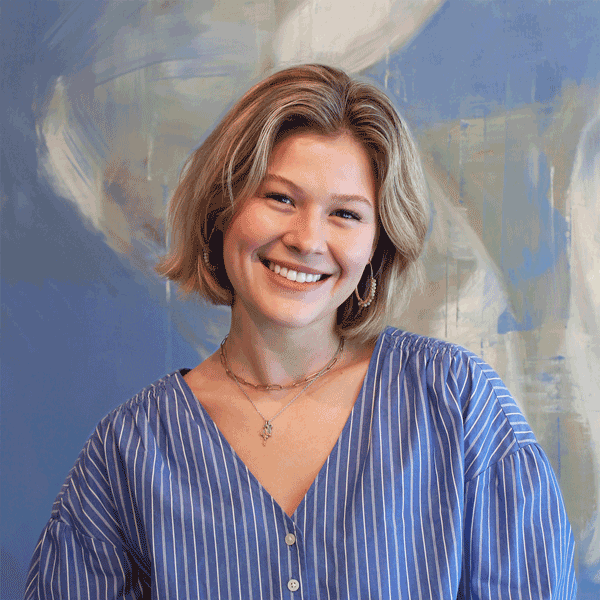
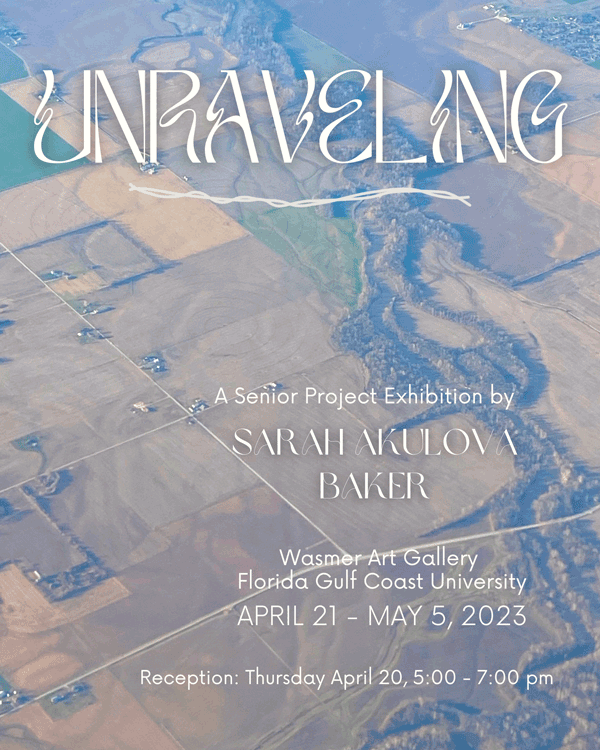
Natural /ˈnatʃ(ə)r(ə)l/
- Existing in or derived from nature; not made or caused by humankind.
Artificial /ɑːtɪˈfɪʃ(ə)l/
- Made or produced by human beings rather than occurring naturally, especially as a copy of something natural.
Historically, fabrics were created from natural fibers such as cotton, linen, and hemp using century-old farming practices that supported the environment. Modern industrial agriculture methods have displaced small-scale growing techniques linked to traditional cultures, climates, and ecosystems. Textiles made of polyester, nylon, and acrylic are now used to produce most apparel. Because so much of the energy required for their manufacture originates from the oil industry, synthetic fibers are a concern. “Fast Fashion” - quickly available, low-cost, on-trend clothing - has democratized fashion, but the human and environmental health concerns connected with low-cost apparel are ubiquitous. My intention with this project is to unravel this progression from natural to artificial seen in our relationship with the environment.
At a young age, my grandmothers, American & Russian (babushka), began teaching me how to knit, sew, and weave, and some of my fondest memories include these visits. When I wasn’t with either of them, I was traveling and living in different parts of the world with my parents. I joke that I was half-raised on a plane and had the most frequent flyer miles of any 10 year old. I always choose a window seat because of the view from 36,000 ft, and I can’t even begin to count how many aerial landscape photos I have taken. Looking down, the world transforms into simplified shapes and patterns that tell a generational story of family, industry, control, and growth. These themes are woven into the clothes we wear and the places we inhabit. Based on these experiences and ideas, I chose to work in fibers for my senior project as a testament to the transformative relationship I enjoyed with my grandmothers.
This project began with a series of miniature studies. From these works I understood how to communicate ideas through different weaving techniques. Looser compositions showing the weft (the vertical strings) evoke a sense of flow and fluidity. Tighter, more rigid designs feel organized and structured. From this knowledge, I made two tapestries. One speaks to the natural, and the other to the artificial. To ensure my materials were sustainably collected and created, the yarn used to create both pieces came from a woman-owned small business specializing in spinning hand-dyed natural fibers. In the middle of the space lies three undulating ropes cascading from the ceiling. This piece is a collaborative effort: the ropes are manipulated clothing donated by classmates, friends, and professors. I cut each garment into strips, tied them together using multiple knots, and painted them black. Together, these woven forms document our contemporary relationship with the land through a nonrepresentational lens.
-
Amanda Claro NATURE'S KIN
Toggle More Info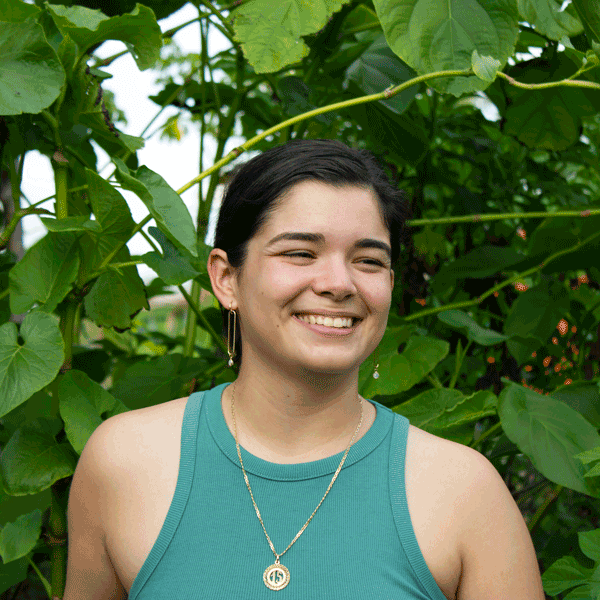
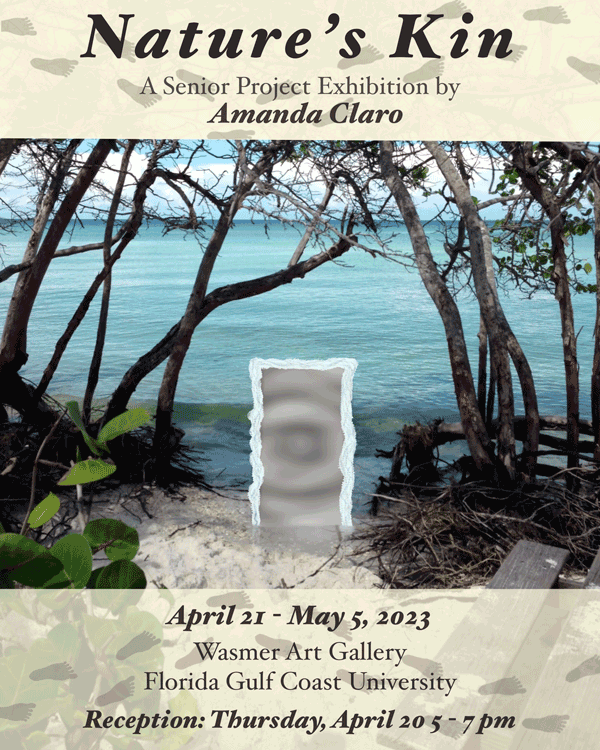
As a society we have pulled away from a close connection with our environment and have put our focus on electronic devices and games. At a young age children are affected the most by this development, leading to the diagnosis of what author Richard Louv has termed “nature-deficit disorder.” The Earth is an ever-present playground waiting to be discovered by all minds, big and small. When a child's relationship with the environment diminishes, their behavior is negatively impacted in many ways. The well-being of all ecosystems is at risk if children have a lack of understanding and respect for Earth's bounty. We, as a collective, must set an example to revitalize our roots in the natural world and encourage child engagement with the outdoors.
During my childhood, I spent a great amount of time visiting state parks and recreational areas throughout Southwest Florida. My family’s appreciation of the environment and respect for natural life was passed on to me as I choose to represent nature within my art supplemented with additional courses in environmental engineering. Unfortunately, I am witnessing a growing disconnect between nature and those closest to me as they are sucked into the indoor digital world. My younger cousins, nephews, and niece are great inspirations in my life and to watch them grow up in a bustling city so attached to their electronics has put into perspective the need for change. My intention for this body of work is to encourage natural curiosity among today's youth and I have specifically based my figures on the forms and interests of my younger relatives. My goal is to renew the youthful connections we all should have to the Earth. My method of choice is to portray this message through an outdoor sculptural installation because I want viewers to come into the space and engage with the figures running about the courtyard, entering in and out through the portals leading to their own worlds.
My journey with creating this outdoor exhibition began with observing and photographing children and their interactions throughout various playful activities, such as hide and seek, hopscotch, and drawing with chalk. Each figure represents local vegetation and natural materials pertaining to a distinct environment, such as beaches, cypress domes, native plants, and gravel beds. I produced several test tiles to investigate different methods of combining these natural mediums with industrial materials, like PVC and expandable foam, in order to create the texture I desired, while giving structural integrity to the figures. From there, I constructed the four child-size figures out of the chosen materials that pertained to each figure, using PVC, expandable foam, and pre-mixed stucco as the internal structure, and sand, cypress bark, preserved moss, gravel, water and preserved plants as the natural materials on the surface of the figure. To fabricate the portals which the figures enter from, I designed foam inserts for four lockers and coated them in the materials related to each child. -
Maria Dominguez IT ENDS WITH ME
Toggle More Info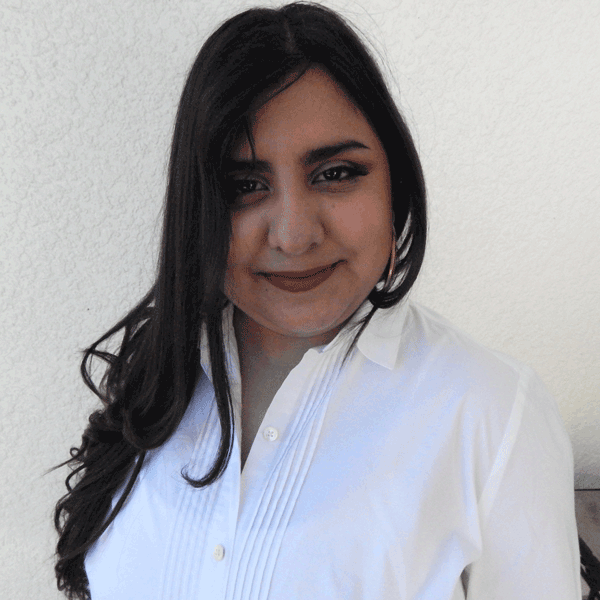
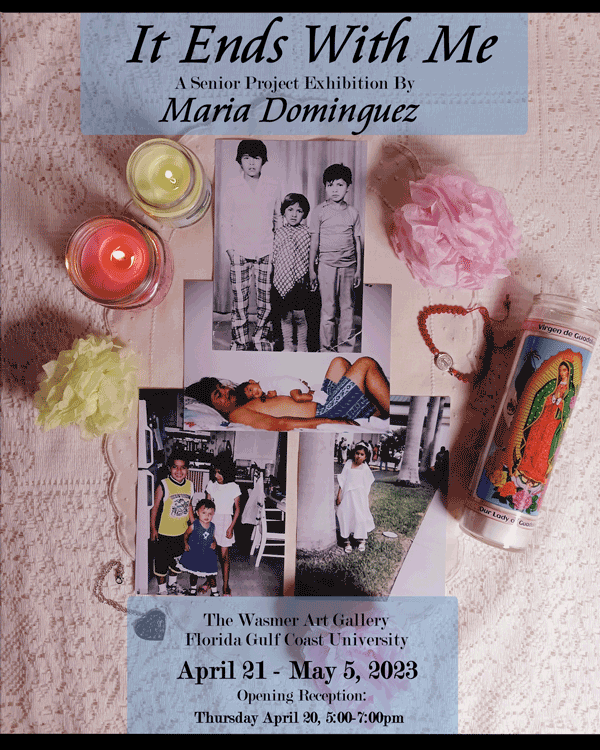
“Hija Mayor
Ya puedes llorar
Y sonreír tambien.
Puedes sanar
Quererles a la distancia
No eres egoísta
Eres tú niña interior un poco triste y
Olvidada...”“Eldest daughter
You can cry now
And you can smile.
You can heal
Love them from a distance
You are not egotistical
You are your inner child who is a bit sad and
Forgotten.."Vianney Harelly (Querida hija mayor from “Here Are the Tears I You We Didn’t Cry”, 2022)
In the United States, the complexities of immigration are usually narrowed down to whether an immigrant arrived into the country legally or not. This binary way of thinking leads to a lack of empathy when discussing unauthorized individuals who are often vulnerable to political attacks and face countless personal struggles in a new country. Caught in the crossfire of these difficult experiences are the children of immigrants. In the United States, 4.9 million children are living with at least one unauthorized parent. Their parents wait in a long and broken queue that makes citizenship an almost impossible path. Due to the fear of deportation, a lack of sense of belonging, complicated separations and reunifications, economic hardship, and an inadequacy of resources and support, the children of immigrants are prone to developing anxiety, depression, and PTSD symptoms. Despite these youth being in a difficult position, they offer great contributions to our society through their acts of translating, interpreting, advocating, and filling out documents for their families.
As a Mexican American woman and first-generation student, I attribute my perseverance and resilience to my parents. I was born in the United States after both of my parents migrated from Mexico in the early 1990s. They made many sacrifices and suffered immensely to give my siblings and I a better life. As a result, I hold an extreme sense of responsibility to my family that unfortunately carries additional sentiments of guilt and depression. When thinking of ways to heal, I was inspired by the altars that Mexican women create in their homes whether in Mexico or living abroad. These altars are part of a tradition passed down through generations of women and are sacred spaces that they depend on for guidance and support. I want to use my voice so that my generation can heal, live free of guilt, and end the cycle of generational trauma.
My altar is composed of a collection of personal items that honor and represent my inner child. Featured on my altar are family photographs, childhood mementos, revered images of religious figures, candleholders, paper flowers, phones, and legal forms. On the wall, I have arranged milagros (figurative clay charms used as petitions and offerings) and woodblock prints depicting the children of immigrants. Ceramics and printmaking are meditative for me, the act of smoothing down clay is as calming and healing as carving into a woodblock. I use earthenware clay with the purpose of representing the deep and rich color of my own skin color and that of my people. The paper flowers on my altar were the result of a meaningful collaboration. With the guidance of the Multicultural and Leadership Development Center at FGCU, I partnered with the Mexican American Student Alliance to create a paper flower workshop. The community that I uncovered through my research, advocacy, and collaborations gave me what I had been yearning for all along: a newfound hope and sense of fulfillment. -
Kevin Hernandez NO WHERE - NI DE AQUI NI DE ALLA
Toggle More Info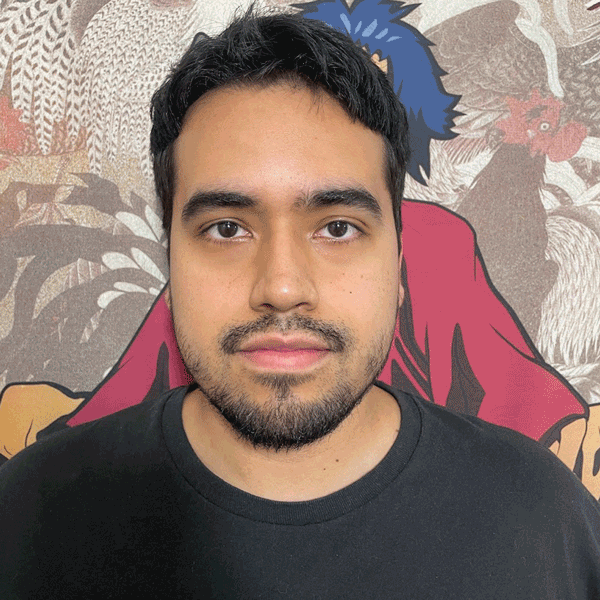

Mesoamerican cultures have fascinated me since I was little, captured by the stories my Mexican father would tell of the history of the various cultures that existed and persist to the present. I was told how we too are connected to this history and the desire grew to reconnect with the past and understand how it influences my present. For my senior project I have explored a contemporary interpretation of Mesoamerican mythology blending Mexican cultural elements with pop culture interpretations to reconcile those indigenous roots with my contemporary American experiences.
As an artist I am deeply passionate about my cultural heritage and the vital importance of celebrating and preserving indigenous cultures. Growing up in the US, I struggled with feelings of displacement and not truly belonging, existing in a space between my Mexican/Indigenous/Colombian roots and the dominant Western culture that prevails both in the US and Latin America. My artwork has become my means to bridge this disconnect by exploring and showcasing the beauty and richness of Mesoamerican mythology while expressing my own unique artistic language that draws from both traditional and contemporary influences. To me, embracing our indigenous roots and incorporating them into modern American and Mexican culture is crucial to building a more inclusive and vibrant society. I'm inspired by popular culture movements that have successfully brought attention to and celebrated Japanese culture, and I hope to achieve a similar impact with my work, bringing attention to the rich cultural heritage of Mexico and Mesoamerica.
As a child, drawing was always my way to express how I felt and what I liked. I especially enjoyed drawing my favorite characters from Japanese manga and anime. For this project I began with hand drawn sketches, then developed these images digitally with a tablet and stylus in Clip Studio Art and Photoshop. Starting with the first layer I begin with a rough sketch in red or blue, this makes it easier to differentiate between the initial rough sketch and the second layer that can be either the clean line art or the start of a painting overlay. By the third layer I lay the base colors of the artwork for example that could be for the hair, skin, or clothes etc. After the base color layers, I begin to render out the illustrations further by adding elements of ambient occlusion and lighting that help build the allusion of depth. After I’m done with a piece, I export it and upload it to my social media sites using a cinematic wide screen format as my template to convey the large scope of the work that conveys the story within the art. -
Kea Suiko Kamiya CONSIDER THE RAVENS
Toggle More Info
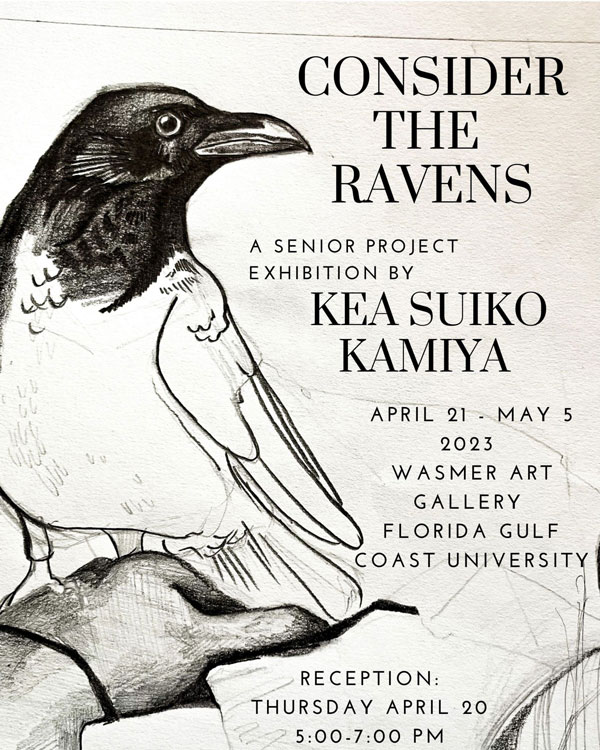
“Consider the ravens: they neither sow nor reap, they have neither storehouse nor barn, and yet God feeds them. Of how much more value are you than the birds! And which of you by being anxious can add a single hour to his span of life?”
Luke 12:24-25 (ESV)
As human beings, we all have the desire to be known and to be cared for. This verse from The Gospel of Luke responds to this desire by comparing God’s care for humanity with his care for the ravens. As we long for our physical needs to be fulfilled, we also long to be known and understood. Within this struggle to identify ourselves, we come across many dualities. Mixed heritages, contradicting character traits, complicated family roles, and other complexities of self disrupt our efforts to have certainty in our identities. When referencing feminist and ecofeminist theory, the identity dualities of man/woman, producer/reproducer, and culture/nature interact in distinct and relevant ways. I have used this exhibition to draw on biblical symbolism, Dionysian philosophy, and ecofeminist dualism to explore my identity and my duality through sculpture and drawings.
I often struggle with feeling unmoored from my sense of self. My heritage is both Asian and White, I am a writer and artist, I work in two and three dimensions, and inhabit many dualities. Instead of succumbing to the pressure to define, reduce, and simplify myself, I have used this work to explore my experience. The figures display the emotions, inner conflict, and vulnerability that the duality of identity brings. The work is a reminder to myself and others that even in this struggle, the figures are not alone. The ravens that accompany the figures serve as a comforting reminder of the Lord’s presence and provision. In many of the drawings the woman appears to look through or past the ravens. Even though the woman does not actively engage with the birds, the ravens are proactively present for her and serve as a reminder of spiritual hope in the midst of earthly struggle. The duality of the spiritual ravens and the earthly figures is underscored by the use of both abstract and representative rendering. The exhibition draws upon dual artistic styles, identity anxiety, and spiritual symbols to demonstrate the dual existence of hope and suffering.
The exhibition considers three moments of the experience of duality. Each of these three moments and poses is rendered through two drawings and one sculpture. I sculpt the ravens in oil-based clay, make a mold in silicone, and cast the final raven in plastic. The ravens are perched on welded steel figures. The interaction of plastic and metal furthers themes of duality through materials. Portions of the drawing are completely rendered, and others are left as schematic lines. This allows me to bring focus to parts of the drawing, employ a further element of duality, and highlight the fact that the drawings are 2-D. These methods allowed me to move towards healing the space between my sense of identity, my outer forms, and my many roles. -
Payton Kern DISORDERED
Toggle More Info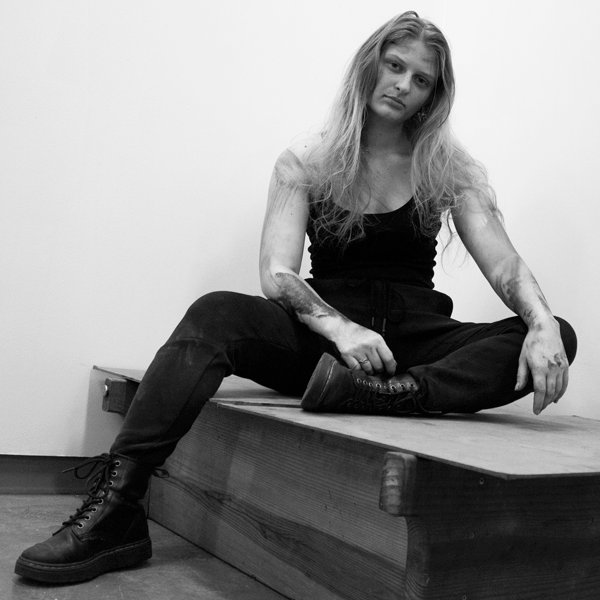
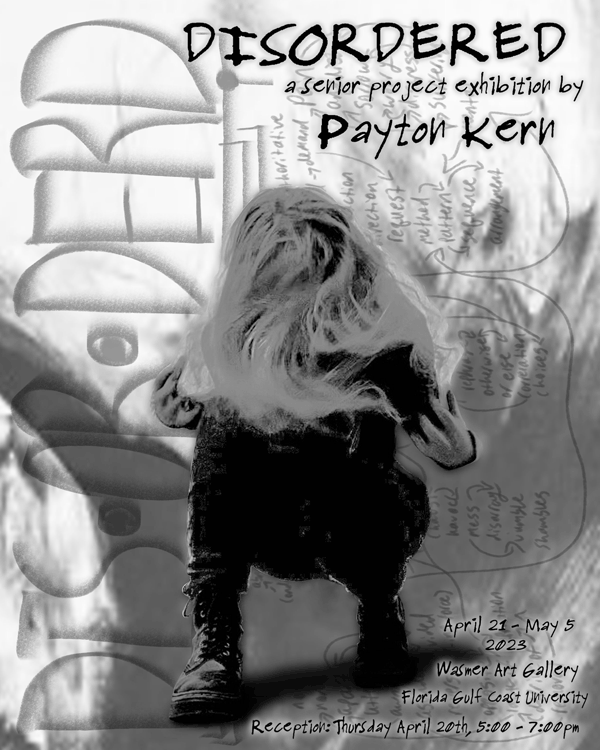
A year ago I went to the doctor with erratic symptoms. It took a while, but we realized I had developed a heart condition and they did everything to find me the right treatment. I was given medication and have been doing fine since. This is how every doctor's visit and health concern should play out, with proper attention and care to finding you help and solutions. Not only with physical health, but with mental health too. It is something everyone deals with, affecting us all in different ways, but is something that can’t be seen through a MRI scan or measured by a blood test. Because of this, our mental health is easily brushed off, overshadowed and overlooked by expectations, opinions, and the thoughts and feelings of others and even our own. We often forget that mental health is not just something you ignore, but that it’s in fact a vital piece of the whole that can’t be ignored. A similar statement can also be made about neurological disorders. Disorders that are thoroughly documented, researched and understood by the scientific community… ones that affect the way we live, think, feel and exist. More often than not these disorders go hand-in-hand with mental health. And yet, like mental health, a lot of neurological disorders are overlooked or misunderstood by those around us.
Mental health and neurological disorders are something I have lived with since I was diagnosed with ADHD, OCD, and Autism Spectrum Disorder at age 5. They always live in the back of my mind, having affected me in many ways throughout my life whether positively or negatively. I have often felt that I have been misunderstood or looked at differently because of my disorders and a lack of understanding towards them, and in many cases I have been made to feel defective when in fact I simply achieve the same things differently. DISORDERED became a way for me to dissect my disorders and the labels I have been given in order to better understand what they are, what they mean, what they do and how it relates to my experiences throughout my life. In doing so, I was able to remind myself that my struggles are valid, that I am valid, and that despite all of these struggles I can still be just as effective as the “normal” person. Afterall, the proof is right here on the wall. DISORDERED also gave me the opportunity to share my thoughts and feelings with those around me, in hopes that I might both educate those who don’t understand, and resonate with those who do.
I represented my ideas through a mix of performative, drawing and printmaking practices, allowing myself to produce raw and free-flowing imagery. I began by taking videos of myself in front of a white wall, playing music to encourage myself to act without the awkward silence in the room as well as to help reflect the mood of the emotions I wanted to portray. From these videos I captured individual still images to use as figurative references. Using Akua ink on plexiglass, I then explored different expressive marks that complimented and added a sense of conversation to the figure and the intended emotion. I ran this through the printing press to create the finished monotype. With the monotype created, I began to place the figure utilizing charcoal and pastel with loose and gestural marks, refining only certain parts of the image while letting other areas flow impulsively. The smaller pieces used a process similar to monotypes, in which I created expressive marks on a transparent sheet. Only now I burned them into a solarplate, a UV activated emulsion on a sheet of metal, to create a permanent and replicable image for printing. The process of creating solarplates is extremely technical, but I was fascinated with the way this method of creation allowed for abstract, expressive marks. -
Eric Krizek IN FAIR VERONA
Toggle More Info
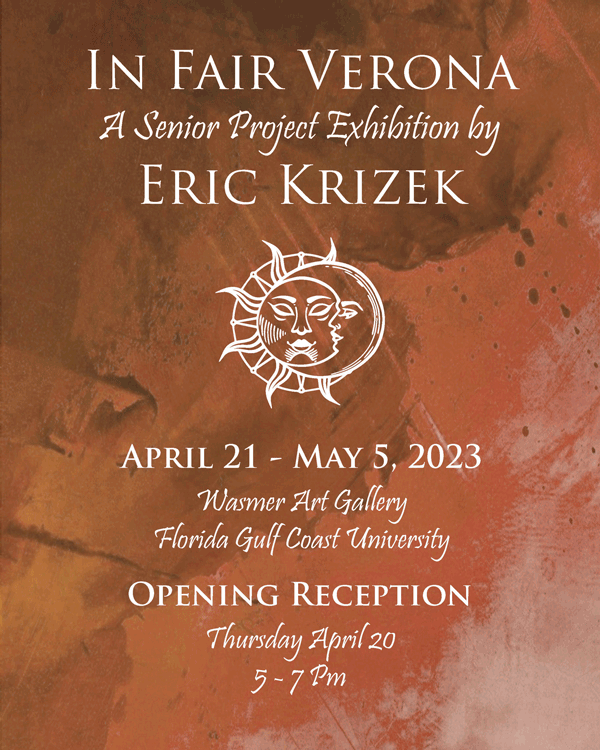
The works of William Shakespeare are foundational texts to the Western literary canon and they reveal deep truths about the human condition that continue to be relevant hundreds of years after they were written. One of those texts, Romeo and Juliet, explores how unresolved conflict and strife can tear families apart, even to the point of death. Not only are the main characters central to this story, but the setting is as well. In Shakespeare’s England, Italy was seen as an exotic land of refinement and courtly splendor, yet also barbarian with its war-torn city-states endlessly competing for power. It was because of this centuries-old reputation for romantic and violent passion that he chose Verona and its prominent feuding families for a story of star-crossed lovers.
As a student majoring in Art and English, Shakespeare and his literary works are fascinating to me. I find Romeo and Juliet especially captivating because, despite the widespread conception of the play as one of the greatest love stories ever told, it is actually more focused on the warring families and their strife. It is only through the unfortunate death of the lovers that the families finally overcome their grievances and resolve to make amends. One of Shakespeare’s symbolic metaphors foreshadows the doomed lovers’ fate by comparing them to the sun and the moon, eternally destined never to be in the same sky together. In my work, I was intrigued by the idea of portraying the core conflict of the plot not with the main characters but with the city of Verona itself, torn apart by the two warring families. Shakespeare never set foot outside of England and used his audience’s collective imagination of these distant places to broaden and deepen the dramatic themes of his plays. This historical fact inspired me to depict Verona as an imagined place influenced by the Italian Renaissance and the Near East rather than the actual location.
I enjoy constructing architectural forms with clay as it offers both flexibility and rigidity in the process of creation. Working with clay in a leather-hard state allows me to carve easily and add architectural details like stairs and crenellations. Windows and archways required an additional level of refinement for clean corners and edges. For the surfaces, I applied different colored slips to the desired areas in order to provide a variation of hues on the clay bodies. The prologue on the pedestal is comprised of vinyl lettering, while the swirling quotes were drawn onto the wall by using a graphite pencil and painted onto the ceramic pieces.
-
Ashlynn Lytle RISK ASSESSMENT
Toggle More Info
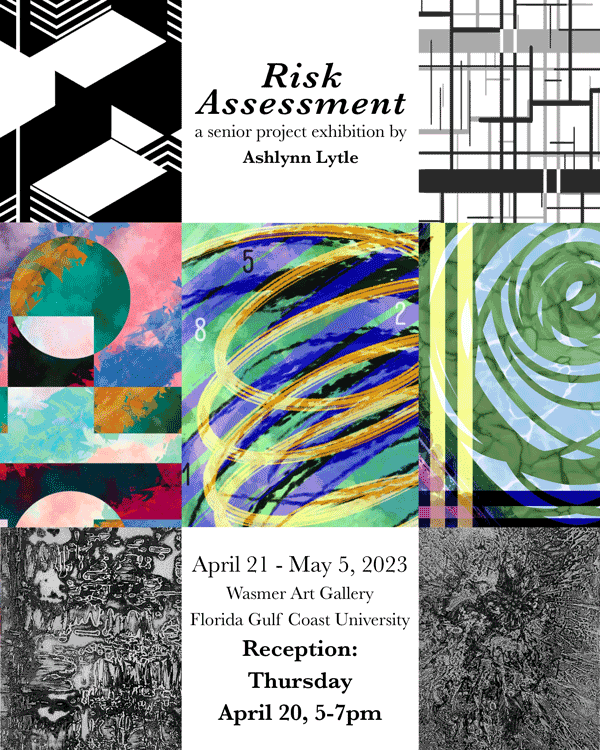
“As humans and living beings, we cannot and do not exist independently. We are only able to live within relationships in this world.”
-Tatsuo Miyajima
When faced with challenges and hardships in our lives, we have many options for how to handle those situations. Within my own life, I have dealt with the difficulties that came from having osteogenesis imperfecta, also known as "brittle bone disease." People with osteogenesis imperfecta are born with it, and there is no cure; but that will not stop me from living a fulfilling life. For me to live the best life I can, I must constantly assess the risk associated with even the most mundane tasks. Although simple tasks like crossing a road or going downstairs seem insignificant to most people, for me they can be very dangerous if I trip or fall, and I have to calculate the best way to carefully handle those tasks. By incorporating this analytical perspective into my life, I have gained a sense of control over the inevitable chaos that could result from a simple misstep. It is this relationship between control and chaos that drives the work for my senior project.
Throughout my life, I have attempted to avoid anything that could endanger my safety at any time. Unfortunately, calculations and precautions can only reduce the chaos so much. In the artwork, I focus on the need for control in my life as a response to the constant feeling of being at risk for injury. Tatsuo Miyajima discussed how everything in the world is related, which I feel is especially true for my perspective of chaos and control. I could not have just one; they both exist together and intermingle daily to create who I am today. In this series of abstract prints, I have separated chaos and control, but they can never truly be apart from each other. The three digital images explore the integration of chaos and control. My intention for this project was to show others that they are not alone if they have similar concerns and that, despite the chaos, you can live a beautiful life.
For this project, I used printmaking in combination with digital drawing to create my work. Printmaking is a medium that I feel gives me the best tools to express the contrasting emotions that I have. I used carved linoleum to create four relief prints representing the control I wish to have over my life. Relief prints allowed me to create geometric compositions with flat colors, with a focus on straight lines and shapes in the negative space. I used solarplates to create four prints to display the inescapable chaos in my life. The solarplates create dynamic and almost organic forms in a way that perfectly describes the unpredictable life that comes with my disorder. For both of these mediums, I used selective color to provide cohesion across the works. In the four controlled prints, I chose to use cool colors to display the peace of mind that comes from being able to feel safe in my surroundings. The bright, warm tones in the other half of the pairs represent how chaos has the ability to ignite at any moment. I created three larger digital drawings using Procreate with vibrant colors to display control and chaos combined. These images are on a larger scale to show how this relationship dominates my life. -
Adrian Matheson MY LIFE AS A DOLL
Toggle More Info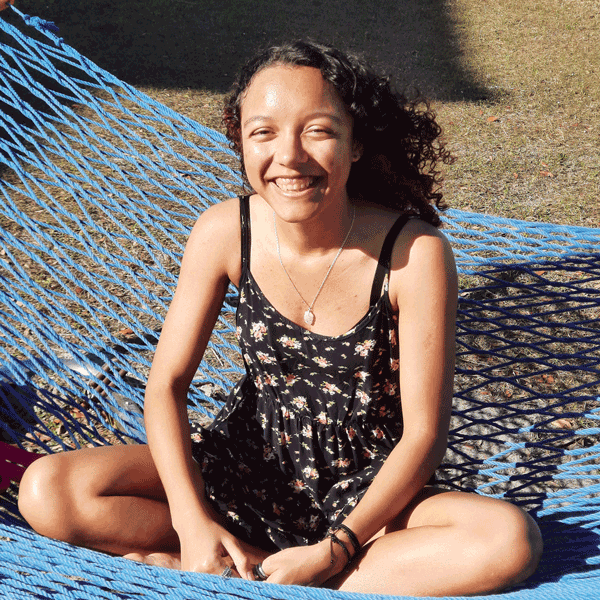
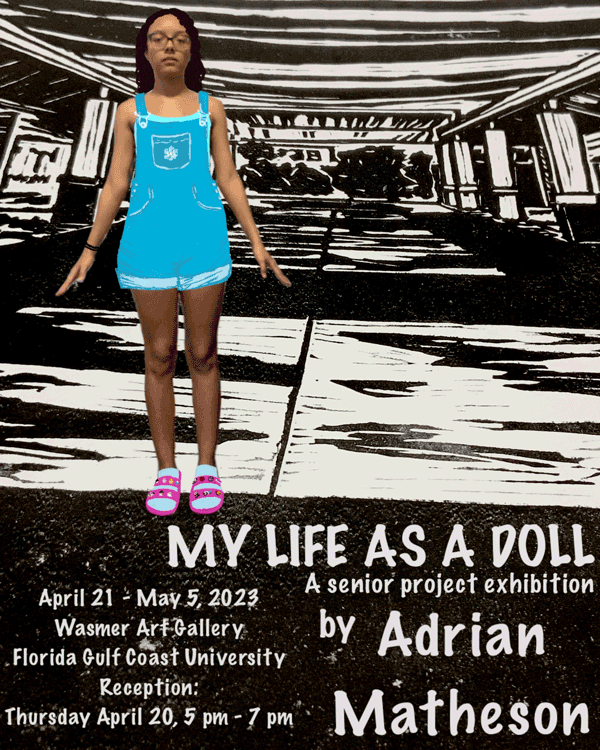
Autobiographical art is created to tell one's story, to communicate the artist's emotions, milestones, thoughts, challenges, and desires. My autobiographical narrative takes place with a doll moving through the pages of a book. Traditionally, dolls have been a representation of expected beauty standards and gender roles. This has been changing in recent years, and they are now being used to highlight and celebrate diversity. My paper doll takes on a contemporary role as it was not made with the intention to enforce social expectations; but to question its position within social expectations. The narrative context is provided through the pages in the book, with settings that are either comfortable and/or uncomfortable. I am inspired by liminal spaces, which can be interpreted both physically and metaphorically. A metaphorical or emotional liminal space represents transitional periods or milestones in life.
The narrative of the book is an episodic telling of my daily life using black and white images of different settings for the doll to move through. There are no words included in this narrative to allow for open interpretation and play. The doll I created is a simplified version of myself, intended to be manipulated by the viewer to explore their interpretations of my life. In social settings I find myself overly cautious of what I am doing and how people perceive me. This causes me to feel like a doll moving through life. The comfortable spaces represented in the book are places where I am not so cautious of the people around me. The uncomfortable spaces are physical representations of anxiety, places where I am uncomfortable with the unknown. As I approach graduation, I am currently in an uncomfortable metaphorical liminal space.
The pages of the book were individually printed with carved linoleum blocks. The pages were assembled by flaps left on both sides of the print, glued to one another and reinforced by tape on the back. The paper doll started out as a photo of me. The photograph was brought into the app Procreate, where I digitally traced my image to create a doll pattern. The pattern was printed, traced onto heavy paper, then colored using alcohol markers. The doll pieces were then cut out and assembled together using pins to create joints allowing for movement. The clothing was also created by digitally tracing photos of myself that were then were printed, colored, and cut out.
-
Sabrina Meads OVERLOAD
Toggle More Info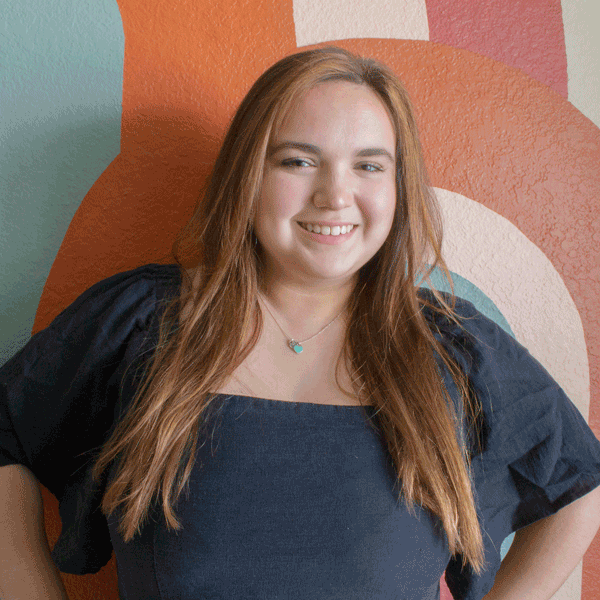
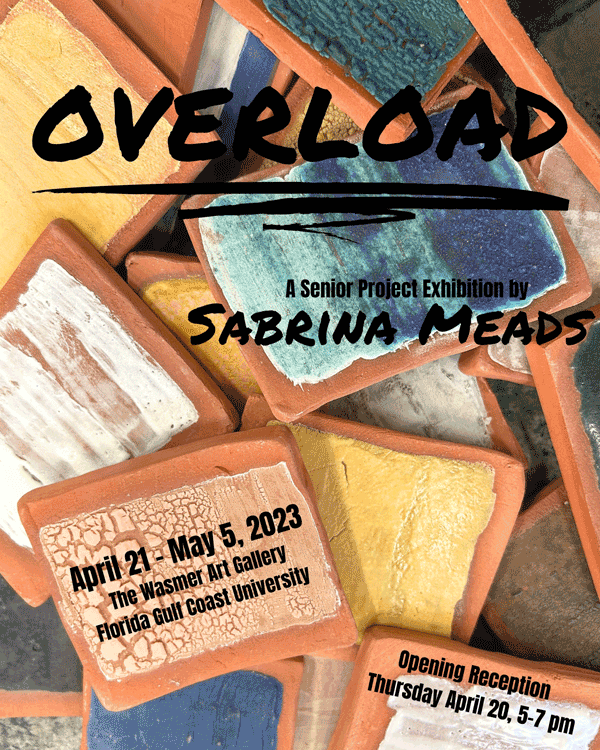
The World Health Organization projects that by 2030, depression will affect 350 million people and become the leading cause of disability-adjusted illness in the world. There are many layers of emotion with depression, which results in an overload of unmanageable feelings. Depression (or major depressive disorder) is a common and serious medical illness that negatively affects how you feel, the way you think, and how you act. The chemical lack of serotonin or dopamine can cause depression, as can life trauma and difficult relationships.
I have struggled with depression for more than ten years, through many days and nights filled with sadness. I did not want to leave my bed, see my friends or complete my schoolwork. Therapy has played a key role in helping me navigate through my ups and downs and better manage my depression. It is hard for me to talk about my sadness to others because I do not want to bring them down or make them feel sad for me - and I really don’t know why I feel sad. My goal lately has been to channel my sadness into studio art production, talk about it more, and learn to cope with depression in a healthy way. Ceramics has really helped - the feeling of clay and getting lost in making objects both functional and sculptural distracts me from the sadness. In this series of sculptures, the abstract forms represent how depression is essentially abstract and different for everyone. The glazes represent the many layers of emotions that come with depression. The numerous colors and textures of the glazes were applied to make each sculpture feel overloaded and overwhelmed.
My sculptures were created with an extruder, a mechanical device that passes clay through a column under pressure and through a shape called a die. With the force of a lever, the clay is pushed through the die to extrude a wide range of clay shapes depending on which die is used. These extrusions are manipulated into the desired forms and assembled to create abstract sculptures. I chose to use earthenware clay because it can be fired many times at lower temperatures. After assembly and drying they are put into the kiln for an initial bisque firing at 1728° F to transform greenware (unfired clay) from its fragile state to a porous and durable state called ceramic prior to the second stage of firing. This is where the glazing process begins. Through extensive testing, I created a series of fifteen low-fire glazes that present different textures and colors. These glazes are applied in layers, and fired multiple times with successive application of glaze between firings until I feel that the form has been appropriately overloaded. -
Keet Medina THE SPIRE
Toggle More Info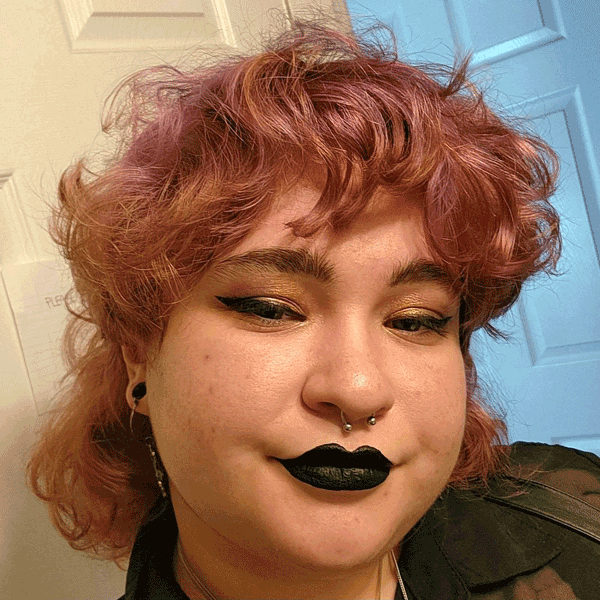
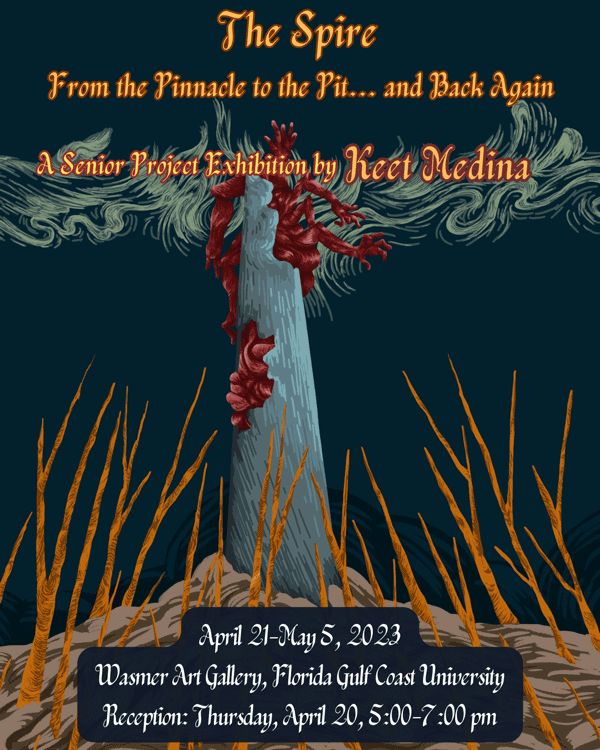
“He who fights too long against dragons becomes a dragon himself; and if you gaze too long into the abyss, the abyss will gaze into you.”
- Friedrich Nietzsche, Beyond Good and Evil
Since the Paleolithic era, telling stories has been our way of communicating with each other and preserving our histories. Stories contain messages of morality, inspiration in the face of adversity, and interpretations of unexplainable or historical events, all of which form a vital part of our collective subconscious. One thing many of these stories seem to have in common is a familiar pattern: the hero departs, faces adversity, and comes back better for it. Mythologist Joseph Campbell describes this narrative pattern as the Hero’s Journey, or the Monomyth. In more recent times, the use of the Monomyth in conjunction with Jungian psychology has been applied to healing the inner self by filling the role of the hero archetype. You are meant to become a hero, navigate the world of the unknown, and return stronger than before.
As a kid growing up with mental health and interpersonal problems, I found comfort within books, in the world of a game, and on the pages of my sketchbook. These were ways for me to have control over my life somehow, to escape from the pain that I could not begin to comprehend as a child. When I did not have the words to describe my fear, my sadness, my fixations, I had art. I would use a visual language to process that which was incomprehensible, as far as I knew. By the time I grew up and finally understood what was wrong with me, it was too late. The damage done by years of neglect and abuse was there. I suffered when I had no need to because no one helped me. This illustrated story is my way of helping myself. Through this project I will become the hero I never had, I will give my monsters a physical form, and I will face them head on.
Before I draw anything, I write the story and make a storyboard for it. This ensures that the narrative flow is cohesive, and that I have a written format to refer to while I work. For my panels begin with pencil, and then outline with pens of varying thickness. Once I’ve finished with the pen, I hand color the images with Copic and Prismacolor alcohol markers for their ease of blending and quality of color. This step-by-step process is important as it streamlines my artistic process and keeps me focused. The acrylic paintings, used to emphasize dramatic moments in the narrative, reflect on the mood of the scene with my choice of color and the energy behind the subjects’ gestures. My choice of materials is just as significant as my composition: they represent the perfect union between the materials I relied on in my darkest hours, and the materials I have learned to love during my time as a student. -
Steven Vittitoe WATCH AND LISTEN
Toggle More Info
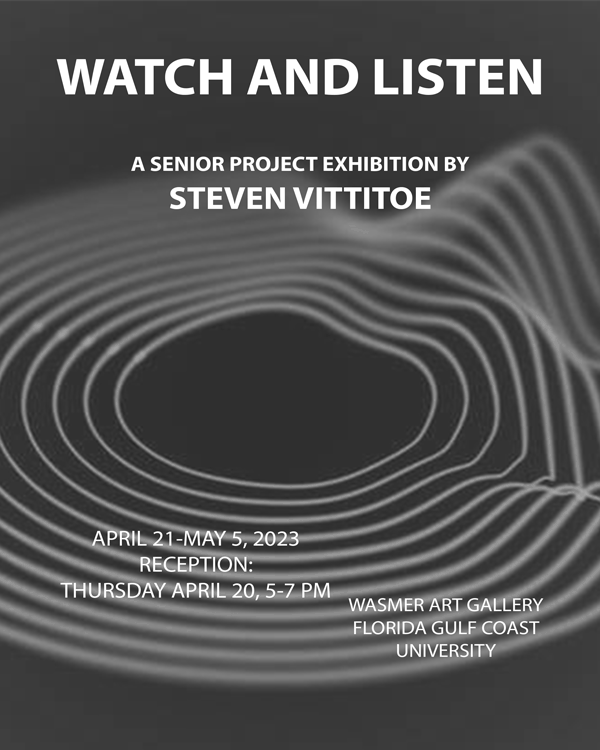
“We are slowed down sound and light waves, a walking bundle of frequencies tuned into the cosmos. We are souls dressed up in sacred biochemical garments and our bodies are the instruments through which our souls play their music.”
-Albert Einstein
The human brain is fragile but strong. It can process information like no other animal, but a little noise can change the way we think and ultimately our mood. Frustration with processing the world around us is directly related to our senses, but we limit ourselves to only a few. Although music is usually recorded in stereo format, with the increasing use of technology, it can be received in different ways to help the audience experience the music more fully. Digital technology has drastically changed how music is listened to and can serve as a therapeutic medium.
After transferring to Florida Gulf University from another college, I struggled with anxiety and occasional depression that became a problem early in my junior year. When I tried salsa dancing my first summer on campus, I was more in tune with my thoughts and feelings than I had ever been before. It became a springboard to listen to different genres of music and start listening sessions in a quiet room. Subtle changes in audio quality and volume had a noticeable effect on my brain, unlike listening to low quality audio. Through both two-dimensional and three-dimensional visualization, this exhibition explores how the brain perceives music, and how I use music as a therapeutic tool to manage negative emotions.
My interest in technology and the various ways I as an artist can express my creativity led me to use digital software to initially interpret my ideas. The work begins by making a digital rendering of the color and lighting using tools that fit the medium I will later use to build the work. I listen to a variety of musical genres while using music visualization software to simulate how the sound might appear after being altered. It really is like pinpointing parts of my brain much like how the different notes light up parts of the visualizer. I am trying to organize my thoughts and ideas in a more concise way for others to understand. For me, digital is better than physical drawing materials because I have more freedom to create or delete as I see fit without the hassle of redrawing from scratch. 3D printing is as much a part of the process as digital imaging, both are used to create sculptures. The unique work that can be accomplished with the use of the 3D printer enhances the imagery and content of the music and artwork. Both are different languages that have the same roots, both use the same software and imagery but translate the music differently. QR codes are provided for viewer interaction; I used Linktree, a social media sharing service, to organize the three songs I chose and created a dynamic QR code that links to all three. Through access to different music streaming services based on individual preference the audience can put on their own headphones and listen to the music that inspired the artworks.
